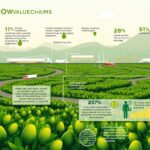In the 2020 election cycle, a shocking 41% of funds came from just 0.5% of households. This fact highlights the big role that mega-donors play in politics. Meanwhile, smaller grassroots movements find it tough to have their voices heard. But, with the 2025 elections coming up, new changes in campaign finance are aiming to shake things up. These reforms are looking to lessen the power of the rich and give more say to regular folks. Getting to know these changes is key for anyone involved in political donations, as they highlight the battle between little guys and big wallets.
Key Takeaways
- The influence of mega-donors in elections is prominent, with a significant portion of contributions coming from a small percentage of households.
- Grassroots movements are essential for amplifying everyday voices in the political arena.
- 2025 election reforms aim to create greater balance in political donations.
- Understanding campaign finance dynamics is vital for voters and advocates alike.
- Recent reforms can shake up traditional political donor landscapes.
The Landscape of Campaign Finance in 2025
The lead-up to the 2025 elections is seeing big changes in campaign finance. People are becoming more aware of how big donors affect elections. This is sparking talks on how to make things better. Public funding efforts are getting more attention as voters want things to be fair and clear.
There’s a tricky mix of state and federal rules on campaign money. Different states are trying to limit the power of rich donors and businesses. But, this effort is showing how divided people are on fixing these issues. This makes finding a common solution hard.
Understanding how these reforms affect democracy is key. Different political groups see the role of money in elections differently. By keeping up with these changes, people can better understand their power in making elections fair in 2025.
Understanding Grassroots Movements
Grassroots movements are a key player in political engagement, coming from communities themselves. Instead of big donors calling the shots, these campaigns start from the ground up. People band together to push for changes they believe in. By gathering small donations and local support, grassroots movements give a loudspeaker to community issues. They’re changing how campaigns are funded.
Definition and Importance of Grassroots
Grassroots movements come from the community and rely on people getting involved. They give people the power to shape politics on issues that matter to them. This involvement is important because it brings many voices to the table. It breaks away from big-money politics, making sure our political system reflects what people really want.
Success Stories from Grassroots Campaigns
Many success stories highlight the strength of grassroots efforts. For example, campaigns in Connecticut and Arizona show how community fundraising can win elections and influence policy. These victories prove grassroots movements can stand up to big-money opponents. They ensure that the voices of regular people are heard in politics.
The Role of Mega-Donors in Elections
Mega-donors play a big role in elections. They give a lot of money, shaping what candidates talk about. This can sometimes make it tough for smaller, community-led groups to have their voices heard. Understanding how these big donors work helps us see how elections are changing.
Influence and Impact of Mega-Donors
Mega-donors have a lot of power because of their money. They can influence what politicians focus on, which can be different from what everyday folks care about. They bring a lot more money to the table than the average person can.
This means they have a big say in what gets talked about in campaigns. Here are some ways they do this:
- Shaping Policies: They push for policies that might not be what most people want.
- Funding Negative Campaigns: They pay for ads that make their opponents look bad, changing the game.
- Backing Extended Networks: By working with other powerful people, they build a web that supports their goals.
Examples of Notable Mega-Donors
Some mega-donors are very well-known for how they use their money in politics. Here are a few:
- George Soros: He gives a lot to Democrats, supporting groups that push for changes he believes in.
- Charles Koch: He’s influenced the Republican Party a lot, promoting ideas that he agrees with.
- Tom Steyer: He cares a lot about the environment and uses his wealth to support related causes.
The work of these mega-donors shows they have a big role in political fundraising. Their influence sparks discussions about democracy today.
2025 Election Reforms Pushing for Change
In 2025, big changes are coming to how elections work. These changes focus on making things more open. They also aim to lessen the power of big-money donors in politics. Moving to a system where public money supports candidates is key.
This change is about everyone having an equal chance in elections. It keeps candidates from depending too much on rich backers. It’s all part of larger efforts to make people trust elections more.
States are stepping up with plans that back public funding. This lets voters chip in with small donations that get matched with public dollars. This means more regular folks can have their say in politics.
It might even reduce the sway that rich donors have held over elections for so long.
There’s also a lot of talk on how to fund campaigns the right way. Making sure money in politics is clean is key to getting more people involved. Lawmakers are working hard on these changes.
They aim to make sure everyone’s voice counts, rich or poor. These efforts are about fairness and rebuilding voter trust.
Grassroots, Mega-Donors, 2025 Election Reforms, Campaign Finance: A Comparative Analysis
This text looks at how grassroots groups and big-money donors are adjusting to the 2025 election changes. We’re seeing a shift. It’s changing how money affects politics, leaning towards fairness. These developments shed light on the changing roles of donors today.
The Shift in Political Donor Dynamics
The 2025 election changes are shaking up political donations. Big donors used to have a lot of power, pushing their own agendas. Now, grassroots efforts are becoming stronger, showing what many people want. This change makes politics more open, encouraging everyone to join in. We’re moving towards funding that stands for shared values and brings in different donors.
Balancing Power in Political Donations
The 2025 changes aim to make donating to politics fairer. They’re about making sure big and small donations are balanced. This means making everything clearer and helping small donations matter more. Now, lots of small donations can together stand up to big money. This helps spread political power more evenly.
Public Financing Initiatives Across the States
Public financing is key for making campaign finance fairer across the U.S. Many state projects aim to improve politics by helping candidates without big donors. Arizona’s Clean Elections system encourages people’s involvement and limits big money’s power.
States have different ways to support public financing. Connecticut, for instance, helps candidates get state funds if they raise many small donations. This pushes candidates to seek grassroots backing to compete against wealthy opponents. New York City’s program makes small donations worth more, helping everyday people influence politics.
These public financing efforts are making a difference; they support grassroots campaigns and make elections more fair. Yet, there are hurdles like funding shortages and low public awareness. It’s important to keep improving these programs so they help democracy and campaign finance better.

Challenges Facing Grassroots Campaigning
Grassroots campaigning is key in shaping democracy, but it faces big obstacles. Main issues include limited funds and tough competition from well-funded candidates. These challenges make it hard for grassroots efforts to stand out.
Funding Limitations and Competition
Funding is a major concern for grassroots campaigns. They often rely on small donations, unlike their well-off opponents who get huge funds from big donors. This makes it tough for them to reach out and build a strong campaign. They struggle to pay for ads, hire staff, and reach out to voters.
Confronting the Power of Mega-Donor Contributions
The power of big donors can create an unfair game. Candidates they support get more media attention and event space, leaving grassroots messages unheard. This can discourage grassroots supporters. Grassroots campaigns need to get creative, engage the community, and find new ways to raise money. They must adapt to get past these financial hurdles and big donor influence.
Campaign Transparency and Accountability
In the world of politics, campaign transparency is key to building trust. Efforts to increase transparency shed light on the complex world of campaign finance. They include various accountability measures to highlight where funds come from.
Laws demand that political donations be clearly reported. This lets voters see who supports candidates financially. These steps are critical for electoral integrity and keeping our democracy safe. Ethics commissions play a big role too, by watching over campaign money and tackling violations.
By enhancing campaign transparency, these actions not only give power back to the people. They also even out the playing field in elections. With better transparency, voters have the knowledge they need. This strengthens the whole electoral system.

The Future of Political Donations
The way we give money to politics is changing fast. To know where donations are headed, we must look at new fundraising trends. These are being shaped by tech and changes in society. Now, thanks to online platforms and social media, it’s easier for many people to donate. This opens the door for more people to have their say in fundraising.
Emerging Fundraising Trends
Looking ahead, we can expect some major trends in donations:
- Digital Platforms: More donations will happen online, making it easy for people to give money and get involved.
- Micro-Donations: Small gifts from many people will become more common, showing the strength of working together.
- Social Media Campaigns: Better connections on social media will help grassroots movements grow, leading to more donations from community support.
Impact of Legislation on Fundraising Practices
New laws will greatly influence how fundraising works. Recent changes to the rules around political money can affect different types of donors:
- Increased Transparency: Tougher reporting rules will let people know where money comes from, raising accountability in political fundraising.
- Support for Grassroots Efforts: Laws reducing big-donor influence will help level the playing field, boosting small-scale campaigns.
- Challenges for Mega-Donors: New restrictions might curb large donations, forcing big donors to rethink their approaches in a changing political scene.
Conclusion
We’ve come to the end of our look at campaign finance. The dance between small donors and big money backers is changing. This is mostly due to the 2025 election reforms. These changes are making political funding more fair. Now, community-driven efforts have more power, urging people to play a bigger part in elections.
Comparing grassroots with big donors shines light on key issues and chances for the future. Even though big donors have a lot of power, grassroots movements are bringing new energy to campaigning. This situation shows why it’s important to keep pushing for clear and honest campaign finance practices.
Your role as a voter is more important than ever. By keeping up-to-date and getting involved, you make sure your voice is heard. It’s key to call for a campaign finance system that is just. It should support democracy and represent everyone in the community.
FAQ
What are the main factors influencing campaign finance in the 2025 elections?
Key factors are grassroots movements and mega-donors. Grassroots movements focus on community and small donations. Meanwhile, mega-donors provide large sums of money. Recent laws also shape how these factors work together.
How do grassroots movements impact elections?
Grassroots movements involve people for change and gather small donations. They can win elections, especially with public financing in places like Connecticut and Arizona.
What is the extent of mega-donors’ influence in political campaigns?
Mega-donors have a big impact. They help shape what candidates focus on and can determine how viable a campaign is. Their money can outshine smaller, grassroots efforts, affecting election results.
What are some key reforms proposed in 2025 regarding campaign finance?
2025 brought reforms focusing on public financing, holding mega-donors accountable, and campaign openness. These changes support fair funding access for all candidates.
How do public financing initiatives support grassroots candidates?
Public financing helps grassroots candidates compete with those funded by mega-donors. Programs in Arizona and Connecticut aim to make sure everyone, especially smaller donors, can impact elections.
What challenges do grassroots campaigns face against mega-donors?
Grassroots campaigns often lack funds and face tough competition from mega-donor-backed rivals. They need creative fundraising and engagement methods to stay competitive.
Why is transparency important in campaign finance?
Openness in finance is key to honest elections and winning public trust. Actions like disclosure laws help voters know where money comes from in politics.
What are the emerging trends in political fundraising?
New trends are using online platforms and social media for small donations. Recent laws also impact how fundraising happens, for both grassroots and big donors.









































































































